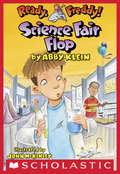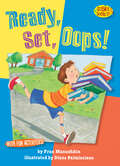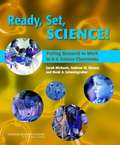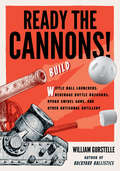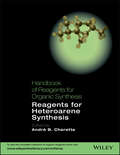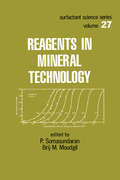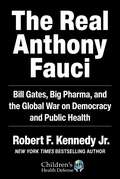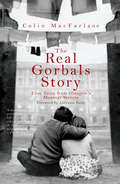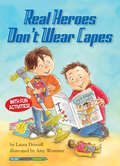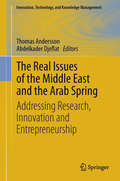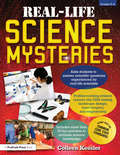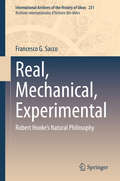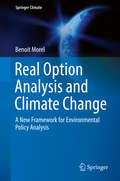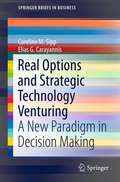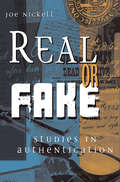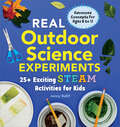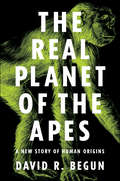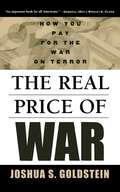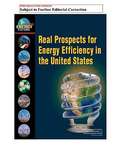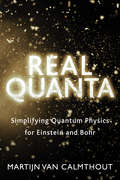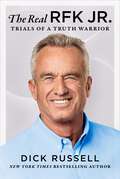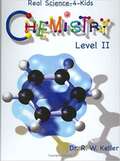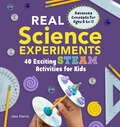- Table View
- List View
Ready, Freddy! Science Fair Flop (Ready, Freddy! #22)
by Abby Klein John MckinleyEveryone's favorite first-grade shark expert is back! With more than 3 million copies sold, it's clear that kids are ready for Freddy! Now that Freddy's in first grade he needs a real science experiment for the school fair. But Freddy isn't a science whiz like his best friend, Robbie. When he finally comes up with a plan -- growing mold -- his mom accidentally throws it away! Can he recreate it in time? Or will the fair be a total flop?
Ready, Set, Oops! (Science Solves It!)
by Fran ManushkinJoey's running to the library--fast. Too fast! But his trips and tumbles won't help him come up with an idea for Science Day. Or will they?
Ready, Set, SCIENCE!: Putting Research to Work in K-8 Science Classrooms
by National Research Council of the National AcademiesWinner of the Association of Educational Publishers 2008 Distinguished Achievement Award. Filled with classroom case studies, this book demonstrates the most effective methods of helping students achieve science proficiency.
Ready the Cannons!: Build Wiffle Ball Launchers, Beverage Bottle Bazookas, Hydro Swivel Guns, and Other Artisanal Artillery
by William GurstelleFrom the author of Backyard Ballistics comes this new DIY handbook on building cannons and other fun things that shoot, from wiffle ball launchers and beverage bottle bazookas to super-powered water guns and model culverins. It combines military history and physics with do-it-yourself projects. Now ordinary folks can construct a dozen awesome artillery devices in their garage or basement workshops using inexpensive household or hardware store materials and this step-by-step guide. Clear instructions, diagrams, and photographs show how to build projects ranging from the simple supersonic ping-pong ball shooter to the more complex replica of the Napoleon Cannon. With a strong emphasis on safety, the book also gives tips on troubleshooting, tells the history of how and when the artillery devices were used, and explains the physics behind the projects. This book will be indispensable for the legions of backyard watergunners, model-rocket launchers, and fireworks fanatics who wish every day was the fourth of July.
Reagents for Heteroarene Synthesis
by André B. CharetteThe Handbook is a compilation of 99 articles on diverse reagents and catalysts that describe the synthesis of heteroarenes, the building blocks of a wide range of chemicals used in pharma and chemical industries. Articles are selected from the e-EROS database and edited to make sure that it includes only the material relevant to the topic of the book and focus on the synthetic aspects. This makes the articles very focused on the needs of readers wanting information on specific syntheses of specific heteroarenes. In addition, the chemistry of each ?parent heteroarene? is also included to ensure that the reader rapidly finds important information. The Handbook is a part of the Handbook of Reagents for Organic Chemistry series, aiming at collecting articles on a particular theme that individual researchers in academia or industry can use on a daily basis.
Reagents in Mineral Technology (Surfactant Science Ser. #27)
by P. SomasundaranReagents in Mineral Technology provides comprehensive coverage of both basic as well asapplied aspects of reagents utilized in the minerals industry.This outstanding, single-source reference opens with an explicit account of flotation fundamentals,including coverage of wetting phenomena, mineral/water interfacial phenomena, flo tationchemistry, and flocculation and dispersion of mineral suspensions.It then discusses flotation of sulfide and nonsulfide minerals, with attention to formation ofclithiolates, formation of metal thiol compounds, application of fatty acids, sulfosuccinic acids,amines, and other collectors.Reagents in Mineral Technology also reviews adsorption of surfactants on minerals .. .details adsorption of polymers .. . and considers the chemistry and application of chelation agentsin minerals separations.Additional chapters consider grinding aids, frothers, inorganic and polymeric depressants,dewatering and filtering aids, analytical techniques, and much more.Unique in its depth of coverage, Reagents in Mineral Technology will prove an invaluablereference for mineral engineers and processors; analytical, surface, colloid, and physical chemists;petroleum, petrochemical, metallurgical, and mining engineers; and for use in advancedundergraduate- and graduate-level courses in these and related fields.
The Real Anthony Fauci: Bill Gates, Big Pharma, and the Global War on Democracy and Public Health (Children’s Health Defense)
by Robert F. Kennedy Jr.#1 on AMAZON, TWENTY WEEKS on the NEW YORK TIMES BESTSELLER LIST, and a WALL STREET JOURNAL, USA TODAY and PUBLISHERS WEEKLY NATIONAL BESTSELLEROver 1,000,000 copies sold despite censorship, boycotts from bookstores and libraries, and hit pieces against the author. Pharma-funded mainstream media has convinced millions of Americans that Dr. Anthony Fauci is a hero. Hands down, he is anything but. As director of the National Institute of Allergy and Infectious Diseases (NIAID), Dr. Anthony Fauci dispenses $6.1 billion in annual taxpayer-provided funding for rigged scientific research, allowing him to dictate the subject, content, and outcome of scientific health research across the globe—truly a dark agenda. Fauci uses the financial clout at his disposal in a back handed manner to wield extraordinary influence over hospitals, universities, journals, and thousands of influential doctors and scientists—whose careers and institutions he has the power to ruin, advance, or reward in an authoritarian manner. During more than a year of painstaking and meticulous research on his laptop and through interviews, Robert F. Kennedy Jr. unearthed a shocking story that obliterates media spin on Dr. Fauci . . . and that will alarm every American—Democrat or Republican—who cares about democracy, our Constitution, and the future of our children&’s health.The Real Anthony Fauci reveals how &“America&’s Doctor&” launched his career during the early AIDS crisis by partnering with pharmaceutical companies to sabotage safe and effective off-patent therapeutic treatments for AIDS. Fauci orchestrated fraudulent do-nothing studies, and then pressured US Food and Drug Administration (FDA) regulators into approving a deadly chemotherapy treatment he had good reason to know was worthless against AIDS. Fauci did the unthinkable and repeatedly violated federal laws to allow his Pharma partners to use impoverished and dark-skinned children as lab rats in beyond order, deadly experiments with toxic AIDS and cancer chemotherapies. In early 2000, Fauci shook hands with Bill Gates in the library of Gates&’ $147 million Seattle mansion, cementing a partnership that would aim to control an increasingly profitable $60 billion global vaccine enterprise with unlimited growth potential. Through funding leverage and carefully cultivated personal relationships with heads of state and leading media and social media institutions, the Pharma-Fauci-Gates alliance exercises dominion over global health policy and our beautiful country. This is not just another political book. The Real Anthony Fauci details how Fauci, Gates, and their cohorts use their control of media outlets—both conservative and liberal leaning, scientific journals, key government and quasi-governmental agencies, global intelligence agencies, and influential scientists and physicians to flood the public with fearful propaganda about COVID-19 virulence and pathogenesis, and to muzzle debate and ruthlessly censor dissent.
Real Chemistry Experiments: 40 Exciting STEAM Activities for Kids (Real Science)
by Edward P. ZovinkaFull STEAM ahead!—21st-century chemistry for kids Chemistry for kids can be so much fun! Real Chemistry Experiments has 40 exciting and engaging experiments with a real-life STEAM (Science, Technology, Engineering, Art, Math) connection for kids. Become a better problem-solver, inventor, and innovator with these fascinating chemistry experiments. Each one has a clear purpose or question that's being asked, step-by-step instructions, a list of materials you'll need, questions to help you record your observations, and more. By the time you're through, you'll have chemistry for kids down to a science! This book of chemistry for kids includes: Easy-to-find materials—From tap water and paper towels, to popsicle sticks and dish soap, the materials needed for these experiments are quick and easy to find. Real-life science—Learn the real chemistry behind how and why each experiment works, like why water and oil don't mix in Oily Oceans, how geodes form in Eggshell Geodes, and more. Chemistry basics—Get tons of info about chemistry and what it is, from the scientific method and the Periodic Table, to atoms and the five main areas of study. Imagine all the things you can learn, create, and discover in this colorful book about chemistry for kids—the sky's the limit!
Real Economics for Real People (3rd Edition)
by Charles L. BallardEconomics applied to everyday life.
The Real Gorbals Story: True Tales from Glasgow's Meanest Streets
by Colin MacFarlaneColin MacFarlane was born in the Gorbals in the 1950s, 20 years after the publication of No Mean City, the classic novel about pre-war life in what was once Glasgow's most deprived district. He lived in the same street as its fictional 'razor king', Johnnie Stark, and subsequently realised that a lot of the old characters represented in the book were still around as late as the 1960s. Men still wore bunnets and played pitch and toss; women still treated the steamie as their social club. The razor gangs were running amok once again, and filth, violence, crime, rats, poverty and drunkenness abounded, just like they did in No Mean City.MacFarlane witnessed the last days of the old Gorbals as a major regeneration programme, begun in 1961, was implemented, and, as a street boy, he had a unique insight into a once great community in rapid decline. In this engrossing book, MacFarlane reveals what it was really like to live in the old Gorbals.
Real Heroes Don't Wear Capes: Heroes (Social Studies Connects)
by Laura DriscollThe popular Social Studies Connects series links history, geography, civics and economics to kids&’ daily lives. Featuring stories with diverse characters who face situations young readers can relate to, these books support reading and social studies skills including researching, inferring, comparing, and communication. An activity to stimulate curiosity about the world is included in each book!With no special powers, no secret identity, and no cape, can someone be a real hero? Ethan thinks so and sets out to prove it! (Social Studies Topic: History & Culture/Heroes)
The Real Issues of the Middle East and the Arab Spring
by Abdelkader Djeflat Thomas AnderssonThe wave of protests and populist uprisings in the Middle East has heightened the focus on a volatile region. But the emphasis on political issues has obscured underlying issues concerning education, infrastructure, research, innovation, entrepreneurship and sustainable economic and social development. This volume, emerging in the aftermath of a conference and workshop on science and technology in the region, presents contributions from a range of experts from the Middle East, Europe, and the United States to provide fresh new insights and perspectives on the challenges and prospects for regional development in the changing global context of our time. The authors explore such topics as: the role of information and communication technologies; mindset change in support of investment in intangible assets and risk-taking; how to approach cultural issues, institutions and governance; collaborations with other regions, and; benchmarking performance while drawing lessons of relevance for the special local context. Ultimately, they offer a number of precise policy recommendations and practical insights for creating an enabling environment for capturing economic, political, and social opportunity.
Real-Life Science Mysteries: Grades 5-8
by Colleen KesslerReal-Life Science Mysteries puts an exciting new spin on scientific thinking by profiling real-life scientists, showing students in grades 5-8 ways they can use science in their everyday lives. From a biologist studying the habits of garter snakes in Manitoba, Canada, to a landscape designer and greenhouse owner in Ohio, the scientists in this book share information and solutions to the thorniest problems they face in their scientific careers.With the more than 30 activities included in Real-Life Science Mysteries, students will be required to try their hand at solving common science problems and performing experiments while learning about real people from diverse backgrounds, all of whom share a love for discovering how they work, why things work, and how they can work better. This book is perfect for any science classroom or young scientists looking to increase their knowledge!Grades 5-8
Real, Mechanical, Experimental: Robert Hooke's Natural Philosophy (International Archives of the History of Ideas Archives internationales d'histoire des idées #231)
by Francesco G. SaccoThis original work contains the first detailed account of the natural philosophy of Robert Hooke (1635-1703), leading figure of the early Royal Society. From celestial mechanics to microscopy, from optics to geology and biology, Hooke’s contributions to the Scientific Revolution proved decisive. Focusing separately on partial aspects of Hooke’s works, scholars have hitherto failed to see the unifying idea of the natural philosophy underlying them. Some of his unpublished papers have passed almost unnoticed. Hooke pursued the foundation of a real, mechanical and experimental philosophy, and this book is an attempt to reconstruct it. The book includes a selection of Hooke's unpublished papers. Readers will discover a study of the new science through the works of one of the most known protagonists. Challenging the current views on the scientific life of restoration England, this book sheds new light on the circulation of Baconian ideals and the mechanical philosophy in the early Royal Society. This book is a must-read to anybody interested in Hooke, early modern science or Restoration history.
Real Option Analysis and Climate Change: A New Framework for Environmental Policy Analysis (Springer Climate)
by Benoit MorelThis book sets out to reframe the theory of real options so that it can be used to support environmental investments for climate change adaptation and mitigation. Climate change policy often involves making decisions that concern extended time periods, and doing so under considerable uncertainty. By expanding and broadening the framework of real options, this book first introduces readers to new ways of quantifying investment decisions that can much more effectively address the shape and size of the uncertainty than traditional approaches using Net Present Value. In turn, the second part of the book applies this new theoretical framework to climate change policy by presenting a number of examples, and by providing a general perspective on investment decisions related to climate change and how to prioritize them.
Real Options and Strategic Technology Venturing
by Caroline M. Sipp Carayannis Elias G.This book seeks to answer "why, when and how are real options used in strategic technology venturing?" This work tests for the role of real options in decision making involving three types of firms in decreasing order of technology-dependence - technology-driven (TD) (where the profit is fully dependent on new technology creation and leveraging), technology-based (TB) (where the profit is enabled and supported by technology) and technology-neutral (TN) (where the profit is almost independent of technology). It also deals with strategic and non-strategic types of decisions driven by real options. This analysis shows that an environment presenting co-opetitive (simultaneous competition and collaboration) conditions triggers the use of real options (why), that serve to transform the position, posture and propensity of businesses to innovate and thus they co-evolve (when) into more effective and efficient forms of businesses (co-specialization) (how). The authors demonstrate that embracing risk and uncertainty can increase levels and probability of new venture formation. However, their simulation also shows that it should be adapted to the risk profile of the firm and that timing is also a factor to be considered. Although engaging the concepts of real options, this analysis does not focus on a specific investment valuation methodology, but highlights the relationship between knowledge and risk and rather addresses the management of mindsets, as moving towards a systematic conceptualization of real options represents a different paradigm in decision making.
Real or Fake: Studies in Authentication
by Joe NickellThe man who is “the embodiment of the Mythbusters, Sherlock Holmes, and Richard Feynman” weeds out the treasures from the shams in artifact investigations (Michael Shermer, founding publisher of Skeptic magazine).Detailing how the pros determine whether an Abraham Lincoln signature is forged or if a photograph of Emily Dickinson is genuine, Nickell, a leader in forgery detection and forensic investigation, provides the essential tools necessary to identify counterfeits. In this general introduction to the principles of authentication, Nickell provides readers with step-by-step explanations of the science used to detect falsified documents, photographs, and other objects, illustrating methods used on hit shows such as Antiques Roadshow and History Detectives.Including fascinating cases drawn from Nickell’s illustrious career, Real or Fake combines historical and scientific investigations to reveal reproductions and genuine objects. Nickell explains the warning signs of forgery, such as patching and unnatural pen lifts; chronicles the evolution of writing instruments, inks, and papers; shows readers how to date photographs, papers, and other materials; and traces the development of photographic processes since the mid-nineteenth century. Lavishly illustrated with examples of replicas and authentic objects inspected by Nickell, Real or Fake includes case studies of alleged artifacts including Jack the Ripper’s diary, a draft of the Gettysburg Address, notes by Charles Dickens, Jefferson Davis’s musket, and debris from the Titanic.“An expert on antique ink and paper, and the forensic analysis of historic documents.” —The New Yorker“Nickell advocates a multifaceted approach that looks at provenance, content, material composition, and scientific analysis.” —Maine Antique Digest
Real Outdoor Science Experiments (Real Science Experiments)
by Jenny BallifHypothesis: You'll love these real outdoor experiments for kids 8 to 12! Dive into the world's most exciting science project—the great outdoors! Covering everything from plants and trees to rocks and weather, this amazing book has real outdoor science experiments for kids, to immerse you in the wonders of science, technology, engineering, art, and math. Discover STEAM outdoors—Learn how the scientific method can help you unlock the secrets of the natural world. Make nature your laboratory—Conduct 30 cool experiments like creating grass ropes, making ink from plants, calculating latitude by the stars, and more. Find answers to your questions—How do sinkholes form? Are leaves in the shade bigger or smaller than leaves in the sun? Get explanations for the science behind each experiment, plus ideas for taking your experiments even further. Get ready to explore the science happening all around you with Real Outdoor Science Experiments.
The Real Planet of the Apes
by David R. BegunWas Darwin wrong when he traced our origins to Africa? The Real Planet of the Apes makes the explosive claim that it was in Europe, not Africa, where apes evolved the most important hallmarks of our human lineage--such as dexterous hands and larger brains. In this compelling and accessible book, David Begun, one of the world's leading paleoanthropologists, transports readers to an epoch in the remote past when the Earth was home to many migratory populations of ape species.Drawing on the latest astonishing discoveries in the fossil record as well as his own experiences conducting field expeditions across Europe and Asia, Begun provides a sweeping evolutionary history of great apes and humans. He tells the story of how one of the earliest members of our evolutionary group--a new kind of primate called Proconsul--evolved from lemur-like monkeys in the primeval forests of Africa. Begun vividly describes how, over the next 10 million years, these hominoids expanded into Europe and Asia and evolved climbing and hanging adaptations, longer maturation times, and larger brains, setting the stage for the emergence of humans. As the climate deteriorated in Europe around 10 million years ago, these apes either died out or migrated south, reinvading the African continent and giving rise to the lineages of the gorilla, chimpanzee, and, ultimately, the human.Presenting startling new insights about our fossil ape ancestors, The Real Planet of the Apes is a book that fundamentally alters our understanding of human origins.
The Real Price of War: How You Pay for the War on Terror
by Joshua S. GoldsteinAre Americans in denial about the costs of the War on Terror? In The Real Price of War, Joshua S. Goldstein argues that we need to face up to what the war costs the average American--both in taxes and in changes to our way of life. Goldstein contends that in order to protect the United States from future attacks, we must fight--and win--the War on Terror. Yet even as President Bush campaigns on promises of national security, his administration is cutting taxes and increasing deficit spending, resulting in too little money to eradicate terrorism and a crippling burden of national debt for future generations to pay.The Real Price of War breaks down billion-dollar government expenditures into the prices individual Americans are paying through their taxes. Goldstein estimates that the average American household currently pays $500 each month to finance war. Beyond the dollars and cents that finance military operations and increased security within the U.S., the War on Terror also costs America in less tangible ways, including lost lives, reduced revenue from international travelers, and budget pressures on local governments. The longer the war continues, the greater these costs. In order to win the war faster, Goldstein argues for an increase in war funding, at a cost of about $100 per household per month, to better fund military spending, homeland security, and foreign aid and diplomacy.Americans have been told that the War on Terror is a war without sacrifice. But as Goldstein emphatically states: "These truths should be self-evident: The nation is at war. The war is expensive. Someone has to pay for it."
Real Prospects for Energy Efficiency in the United States
by National Academy Of Sciences National Academy of Engineering National Research Council of the National AcademiesFor multi-user PDF licensing, please contact mailto:customer_service@nap.edu customer service. America's economy and lifestyles have been shaped by the low prices and availability of energy. In the last decade, however, the prices of oil, natural gas, and coal have increased dramatically, leaving consumers and the industrial and service sectors looking for ways to reduce energy use. To achieve greater energy efficiency, we need technology, more informed consumers and producers, and investments in more energy-efficient industrial processes, businesses, residences, and transportation. As part of the America's Energy Future project, Real Prospects for Energy Efficiency in the United States examines the potential for reducing energy demand through improving efficiency by using existing technologies, technologies developed but not yet utilized widely, and prospective technologies. The book evaluates technologies based on their estimated times to initial commercial deployment, and provides an analysis of costs, barriers, and research needs. This quantitative characterization of technologies will guide policy makers toward planning the future of energy use in America. This book will also have much to offer to industry leaders, investors, environmentalists, and others looking for a practical diagnosis of energy efficiency possibilities.
Real Quanta: Simplifying Quantum Physics for Einstein and Bohr
by Martijn Van CalmthoutAlbert Einstein and Niels Bohr walk into the famous Hotel Métropole and sit down at the author’s table to discuss the state of quantum mechanics today. Particles that exist in two places at once, consequences that occur without a cause, objects that exist only if you look at them — quantum mechanics proves that all of this is possible, and not just in dark science labs. Look no further than your smartphone or tablet for technology made conceivable by quantum theory. From quantum computers to “teleporting” data, medicine to photosynthesis and the quantum compass in some migratory birds, Martijn van Calmthout plainly explains — to his readers and to an astounded Einstein and Bohr — how Quantum 2.0 is increasingly part of everyone’s daily life. Rather than being the exceptional domain, Van Calmthout shows how quantum mechanics is actually part of our tangible world, and may even be the very crux of our existence.
The Real RFK Jr.: Trials of a Truth Warrior
by Dick RussellAn epic biography filled with drama, conflict, and surmounted challenges.The Real RFK Jr. is an intimate biographical portrait examining the controversial activist's journey from anguish and addiction to becoming the country's leading environmental champion fighting government corruption, corporate greed, and a captured media. Written by his longtime colleague Dick Russell, the biography also exposes the misconceptions and explains the rationale behind Kennedy's campaign to protect public health. Provided exclusive source material, including access to Kennedy&’s unpublished writings and personal journals, the author conducted dozens of interviews with him as well as numerous friends and associates. Russell delves into everything from Kennedy&’s sometimes death-defying river rafting adventures to his pioneering legal cases against polluters such as Smithfield Foods and Monsanto, while founding the world&’s largest water protection group. The Real RFK Jr. also examines Kennedy&’s pursuit of the truth about the assassinations of his father and uncle, the wrongful murder conviction of his cousin, and the false narratives around the COVID-19 pandemic.
Real Science-4-kids Chemistry Level 2 Student Text
by Rebecca Keller KellerReal Science-4-Kids, Chemistry Level II, Student Textbook
Real Science Experiments: 40 Exciting STEAM Activities for Kids (Real Science)
by Jessica HarrisTake your scientific exploration to the next level with real experiments for kids ages 8 to 12 Here's a hypothesis you can prove: science is a ton of fun! These science experiments for kids give you the opportunity to test this theory using 40 exciting activities that teach you all about science, technology, engineering, art, and math—the full STEAM package! From microscopes and candle-powered boats to insect mind control and hydroponics, these science experiments for kids offer a hands-on approach to scientific discovery. Each of these engaging and repeatable experiments give you the chance to get up-close, personal, and creative with all kinds of amazing ideas that will show you how to be a real scientist. This collection of science experiments for kids includes: STEAM for you—Take STEAM learning into your own hands with awesome, easy-to-do science experiments for kids that are perfect for doing at home. Science made simple—From hypothesis to observation to results, learn all about the power of the scientific method—and how you can use it every day. Hows and whys—Each of these science experiments for kids details exactly why things happen the way they do, helping you better understand the results you see. Take your first step into a world of scientific discovery with the help of these amazing science experiments for kids.
